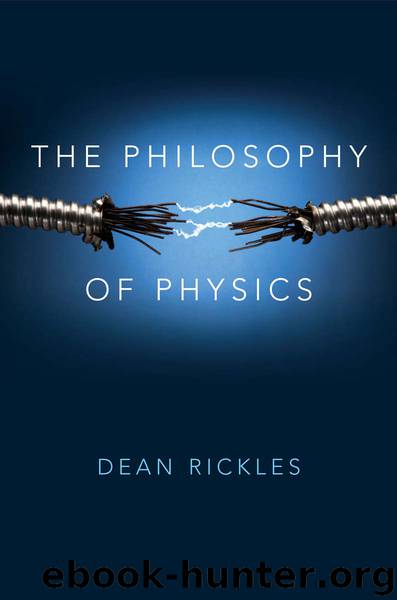The Philosophy of Physics by Rickles Dean;

Author:Rickles, Dean;
Language: eng
Format: epub
Publisher: Wiley
Published: 2016-07-04T00:00:00+00:00
Fig. 6.4 Worldlines of the two particles from the previous movies, which you can think of as a photographs with a ten-second exposure time. Naturally, this picture would be the same for t and −t cases.
So the challenge for the theory is to find a way of getting time-asymmetric processes out of the time-symmetric laws, the former somehow emerging from the latter. Putting it in terms from above: how do we get time-asymmetric macromovies from time-symmetric micromovies? If it is possible (in terms of the microlaws) for all of the particles in a gas to undergo inverse motions (e.g. by flipping the signs of particle velocities), of a kind corresponding to the time-reverse of the gas in the box (or elevator!), then why do we not observe such things happening? From whence the arrow of time?
Ludwig Boltzmann attempted to resolve these problems after they were raised by Josef Loschmidt – the point is known as “Loschmidt’s Objection.” The crux of it is that given the time-symmetric nature of the laws governing the particles making up macroscopic systems, we ought not to see time asymmetric behavior. Entropy decreasing jumps, such as spontaneous coffee/milk unstirring should be observable. As philosopher Huw Price puts it: symmetry in, symmetry out. Conversely, to get an asymmetry out demands an asymmetry in the input. This input asymmetry, as discovered by barrister-turned-physicist Samuel Burbury, is the assumption of molecular chaos: pre-collision particles (i.e. their velocities and positions) are uncorrelated (probabilistically independent: random), but not so post-collision. In other words, the collisions of the particles are responsible for the observed entropy increase such that for any given distribution of states of the particles, it will inevitably evolve into an equilibrium state (the maximally random Maxwell state). Of course this leaves a problem that we will turn to in §6.7: if the system is already in a high entropy state, then it has nowhere to go. One needs some asymmetry in the dynamical evolution, but also an asymmetry in the boundary conditions: one needs lower entropy in the past so that the dynamical asymmetry can generate its effect.
Download
This site does not store any files on its server. We only index and link to content provided by other sites. Please contact the content providers to delete copyright contents if any and email us, we'll remove relevant links or contents immediately.
The Complete Stick Figure Physics Tutorials by Allen Sarah(6638)
Secrets of Antigravity Propulsion: Tesla, UFOs, and Classified Aerospace Technology by Ph.D. Paul A. Laviolette(3450)
Thing Explainer by Randall Munroe(3328)
The River of Consciousness by Oliver Sacks(2992)
The Order of Time by Carlo Rovelli(2714)
I Live in the Future & Here's How It Works by Nick Bilton(2524)
How To by Randall Munroe(2476)
A Brief History of Time by Stephen Hawking(2474)
The Great Unknown by Marcus du Sautoy(2186)
What If?: Serious Scientific Answers to Absurd Hypothetical Questions by Randall Munroe(2170)
Blockchain: Ultimate Step By Step Guide To Understanding Blockchain Technology, Bitcoin Creation, and the future of Money (Novice to Expert) by Keizer Söze(2138)
Midnight in Chernobyl by Adam Higginbotham(2078)
Networks: An Introduction by Newman Mark(1998)
The Meaning of it All by Richard Feynman(1909)
Easy Electronics by Charles Platt(1864)
The Tao of Physics by Fritjof Capra(1850)
When by Daniel H Pink(1777)
Midnight in Chernobyl: The Untold Story of the World's Greatest Nuclear Disaster by Adam Higginbotham(1775)
Introducing Relativity by Bruce Bassett(1755)
